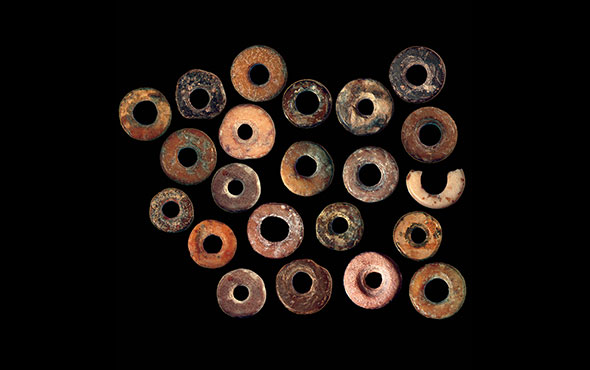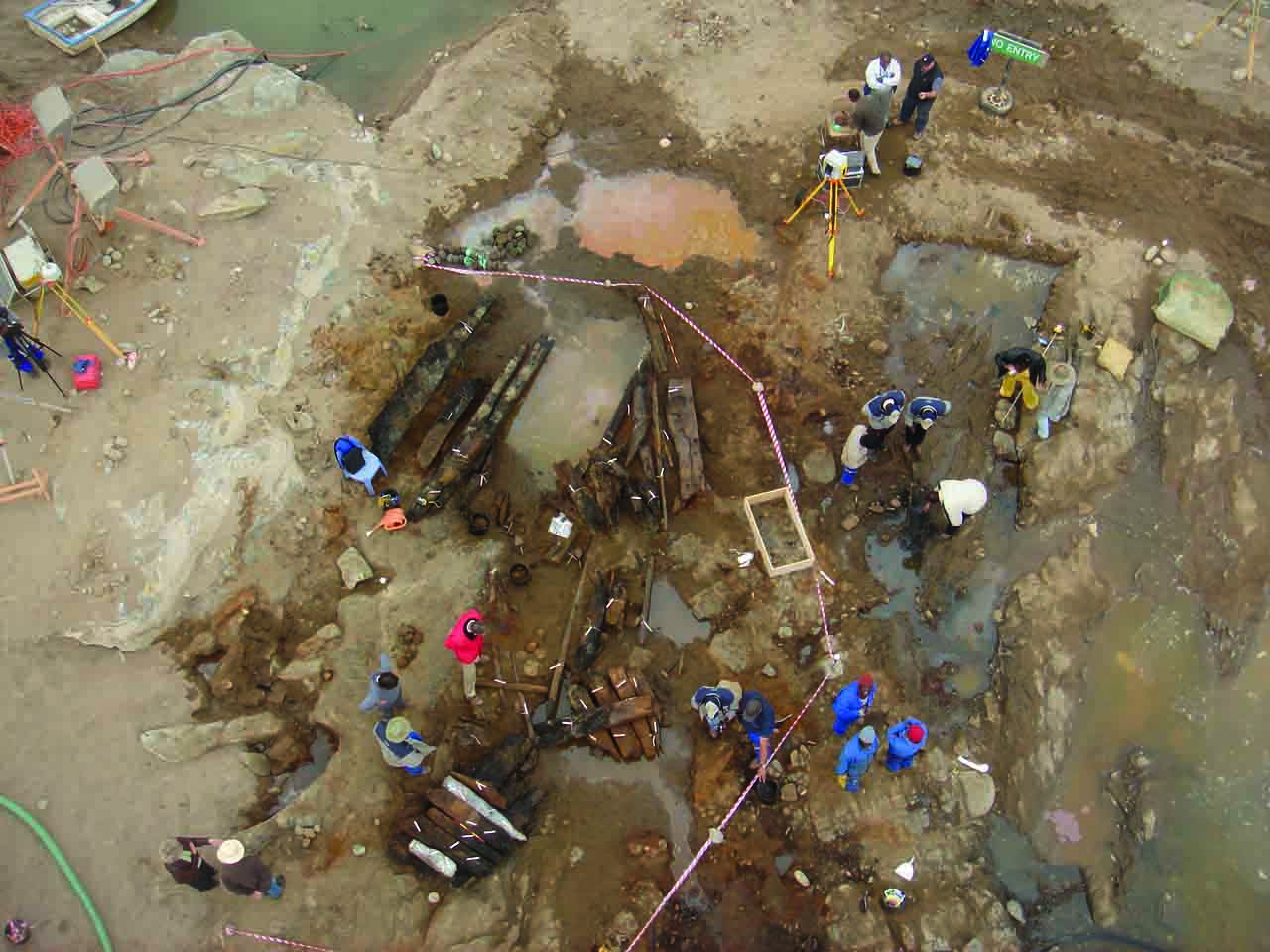
(EPA/Bernd Weissbrod)
A multinational team of researchers at the site of Jebel Faya in the United Arab Emirates has gathered evidence that now suggests that groups of Homo sapiens may have migrated from Africa across the southern end of the Arabian Peninsula as early as 125,000 years ago. Until recently, researchers believed that our species may have made some attempts to travel out of Africa around 120,000 years ago, but had been pushed back by an inhospitable climate and competition with other hominin groups. The prevailing wisdom has been that Homo sapiens didn't make a permanent move into the rest of the world until about 70,000 years ago, presumably when they had achieved some cultural innovations that let them out-compete other hominin species including the now-extinct Homo erectus, Homo heidelbergensis, and Neanderthals. The evidence from Jebel Faya might move that date earlier and add another layer of complexity to the story of modern human migration.
While the findings are somewhat circumstantial, they place this migration at roughly the same time that other groups of Homo sapiens are believed to have made their way across the Sinai peninsula at the northern end of the Red Sea to settle sites in modern-day Israel. Among the intriguing questions raised by this evidence is what kinds of conditions finally came into play 125,000 years ago to facilitate a migration?
Homo sapiens was not the first group of hominins to journey into the world beyond Africa. Groups of the now-extinct species Homo erectus are known to have lived in what are now Spain and the Republic of Georgia around 1.8 million years ago. Homo sapiens likely evolved some time around 200,000 years ago from the groups of Homo erectus who had remained in Africa. A standing question is whether the spread of Homo sapiens led directly—either because of competition, or because of interbreeding, or both—to the demise of the other hominin groups. Tracing the migratory patterns of Homo sapiens is thought to be one way of discovering, ultimately, what happened to the others.
Jebel Faya is a collapsed rock shelter that contains evidence of several distinct periods of occupation from roughly 125,000 years ago to 34,000 years ago. The site lies at the base of a mountain, near the mouth of a valley and a now-dry lake basin. A key piece of evidence about a possible early Homo sapiens occupation comes via the stone tools from the shelter's oldest layers, which are dated to between 125,000 and 90,000 years ago. According to Anthony Marks of Southern Methodist University, these tools, notably, were made using techniques similar to those being practiced in eastern Africa by Homo sapiens at that time. They are also markedly different from tools made by both Homo sapiens and Neanderthals living farther north in the Levant and in Iran's Zagros mountains. Marks believes that this shows that the earliest people to settle Jebel Faya came from eastern Africa, without passing through the Sinai farther north, and supports the idea of an early southern migration.
Although fewer than a dozen stone tools from the site's earliest occupants were found, they show that the people there were making tools using a bifacial flaking technique, meaning that flakes were struck from both the top and bottom faces of a stone to make a blade. "Earlier than 200,000 years ago, there is not a sign of any [tools being made using] bifacial reduction in the Levant or in the Zagros anywhere," says Marks. "On the other hand, in East Africa and Northeast Africa, bifacial reduction is a constant part of the people's technical repertoire." At Jebel Faya they also made a stone tool called a "foliate," which is shaped like a leaf and it, too, is similar to a type of tool made in Northeast Africa, but not in areas north of the site. One challenge in determining who occupied the site is that no bones of any hominin species from this time period have been found there. However, according to project director Hans-Peter Uerpmann of the University of Tübingen, and Marks, bones of Homo sapiens have been found with comparable stone tools in Northeast Africa. In addition, Jebel Faya is located far south of the areas where Neanderthals were living at this time. The conclusion is that anatomically modern humans were the earliest occupants of Jebel Faya. And due to the absence at the site, after 90,000 years ago, of the kinds of stone tools that they made, it is believed that they left.
According to the archaeological findings, later residents of the site appear to have migrated there from the north. A collection of stone tools believed to date between 90,000 and 40,000 years ago seem to have been derived directly from the tool-making traditions of people who lived in the Levant or the Zagros mountains.
When glaciers in Europe and Asia were at their largest, from about 200,000 to 135,000 years ago, the Arabian Peninsula was drier. The expanding deserts would have served as barriers to people attempting to migrate from Africa at that time. Earlier hominins, such as Homo erectus, had the advantage of leaving Africa millions of years earlier, probably while the Arabian Peninsula was relatively wet, making it easier to travel and find food. Homo sapiens may not have been able to expand into the rest of the world because they hadn't developed techniques to carry enough provisions to cross the deserts. They may only have been capable of leaving Africa when the wetter conditions created by retreating glaciers made it possible for them to do so. Uerpmann says, "Now we see that it was the environment that was the key to this [leaving Africa]." According to the climate data assembled by the team's paleoclimatologist, Adrian Parker of Oxford Brookes University, between 135,000 and 120,000 years ago, the water level in the Red Sea would have been low enough to make the crossing to the Arabian Peninsula possible and it would have had a mild enough climate to make it inviting to people looking for a new home.
The climate, however, is believed to have become, once again, much drier by some 90,000 years ago. The earliest people at Jebel Faya may then have gone back to Africa when the climate became inhospitable and it may be that this early attempt by Homo sapiens to expand their range beyond Africa failed—even if temporarily. The sites of Skhul and Qafzeh in modern-day Israel contain evidence that Homo sapiens lived at those sites around 120,000 to 81,000 years ago, but then evidence of them also disappears. And while stone tools recovered from the site of Jwalapuram in India indicate that Homo sapiens may have made it there by about 78,000 years ago, there are no human bones to confirm conclusively that the species lived at the site. It is still possible, then, that the migration that led Homo sapiens to finally spread across the globe took place later.
One additional problematic issue is that the archaeological data doesn't currently match well with the information provided by genetics research. DNA points to the idea that Homo sapiens was present in Southern Asia by 70,000 to 50,000 years ago, but this may just mean that a migration that took place around that time had a much larger impact on the modern gene pool, essentially wiping out any genetic evidence of earlier migrations.
While the Jebel Faya team's findings may not provide a conclusive answer about when that southern migration took place, and what it meant to the spread of modern humans across the globe and their impact on other hominin species, they are an essential step in building an understanding of how we came to dominate the planet. "I think we can never be sure of anything that is only based on one single site," says Uerpmann. "I think that our findings just open our views and tell us where to look for further evidence."











